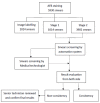Evaluation of an AI-Based TB AFB Smear Screening System for Laboratory Diagnosis on Routine Practice
- PMID: 36366194
- PMCID: PMC9657727
- DOI: 10.3390/s22218497
Evaluation of an AI-Based TB AFB Smear Screening System for Laboratory Diagnosis on Routine Practice
Abstract
The most robust and economical method for laboratory diagnosis of tuberculosis (TB) is to identify mycobacteria acid-fast bacilli (AFB) under acid-fast staining, despite its disadvantages of low sensitivity and labor intensity. In recent years, artificial intelligence (AI) has been used in TB-smear microscopy to assist medical technologists with routine AFB smear microscopy. In this study, we evaluated the performance of a TB automated system consisting of a microscopic scanner and recognition program powered by artificial intelligence and machine learning. This AI-based system can detect AFB and classify the level from 0 to 4+. A total of 5930 smears were evaluated on the performance of this automatic system in identifying AFB in daily lab practice. At the first stage, 120 images were analyzed per smear, and the accuracy, sensitivity, and specificity were 91.3%, 60.0%, and 95.7%, respectively. In the second stage, 200 images were analyzed per smear, and the accuracy, sensitivity, and specificity were increased to 93.7%, 77.4%, and 96.6%. After removing disqualifying smears caused by poor staining quality and smear preparation, the accuracy, sensitivity, and specificity were improved to 95.2%, 85.7%, and 96.9%, respectively. Furthermore, the automated system recovered 85 positive smears initially identified as negative by manual screening. Our results suggested that the automated TB system could achieve higher sensitivity and laboratory efficiency than manual microscopy under the quality control of smear preparation. Automated TB smear screening systems can serve as a screening tool at the first screen before manual microcopy.
Keywords: acid-fast bacilli; artificial intelligence; tuberculosis.
Conflict of interest statement
The authors declare no conflict of interest. The funders had no role in the design of the study; in the collection, analyses, or interpretation of data; in the writing of the manuscript; or in the decision to publish the results.
Figures






Similar articles
-
Pulmonary Tuberculosis Diagnosis Using an Intelligent Microscopy Scanner and Image Recognition Model for Improved Acid-Fast Bacilli Detection in Smears.Microorganisms. 2024 Aug 22;12(8):1734. doi: 10.3390/microorganisms12081734. Microorganisms. 2024. PMID: 39203575 Free PMC article.
-
Retrospective validation of MetaSystems' deep-learning-based digital microscopy platform with assistance compared to manual fluorescence microscopy for detection of mycobacteria.J Clin Microbiol. 2024 Mar 13;62(3):e0106923. doi: 10.1128/jcm.01069-23. Epub 2024 Feb 1. J Clin Microbiol. 2024. PMID: 38299829 Free PMC article.
-
Novel TB smear microscopy automation system in detecting acid-fast bacilli for tuberculosis - A multi-center double blind study.Tuberculosis (Edinb). 2022 Jul;135:102212. doi: 10.1016/j.tube.2022.102212. Epub 2022 May 18. Tuberculosis (Edinb). 2022. PMID: 35609488 Free PMC article. Clinical Trial.
-
Factors affecting the clinical value of microscopy for acid-fast bacilli.Rev Infect Dis. 1984 Mar-Apr;6(2):214-22. doi: 10.1093/clinids/6.2.214. Rev Infect Dis. 1984. PMID: 6203161 Review.
-
Cerebrospinal fluid AFB smear in adults with tuberculous meningitis: A systematic review and diagnostic test accuracy meta-analysis.Tuberculosis (Edinb). 2022 Jul;135:102230. doi: 10.1016/j.tube.2022.102230. Epub 2022 Jun 24. Tuberculosis (Edinb). 2022. PMID: 35779498 Free PMC article.
Cited by
-
Pulmonary Tuberculosis Diagnosis Using an Intelligent Microscopy Scanner and Image Recognition Model for Improved Acid-Fast Bacilli Detection in Smears.Microorganisms. 2024 Aug 22;12(8):1734. doi: 10.3390/microorganisms12081734. Microorganisms. 2024. PMID: 39203575 Free PMC article.
-
Comparative analysis of five etiological detecting techniques for the positive rates in the diagnosis of tuberculous granuloma.J Clin Tuberc Other Mycobact Dis. 2023 May 27;32:100378. doi: 10.1016/j.jctube.2023.100378. eCollection 2023 Aug. J Clin Tuberc Other Mycobact Dis. 2023. PMID: 37293271 Free PMC article.
-
Retrospective validation of MetaSystems' deep-learning-based digital microscopy platform with assistance compared to manual fluorescence microscopy for detection of mycobacteria.J Clin Microbiol. 2024 Mar 13;62(3):e0106923. doi: 10.1128/jcm.01069-23. Epub 2024 Feb 1. J Clin Microbiol. 2024. PMID: 38299829 Free PMC article.
-
Automatic identification of clinically important Aspergillus species by artificial intelligence-based image recognition: proof-of-concept study.Emerg Microbes Infect. 2025 Dec;14(1):2434573. doi: 10.1080/22221751.2024.2434573. Epub 2024 Dec 9. Emerg Microbes Infect. 2025. PMID: 39585232 Free PMC article.
-
Use of a convolutional neural network for direct detection of acid-fast bacilli from clinical specimens.Microbiol Spectr. 2025 Aug 5;13(8):e0060225. doi: 10.1128/spectrum.00602-25. Epub 2025 Jun 23. Microbiol Spectr. 2025. PMID: 40548735 Free PMC article.
References
-
- World Health Organization . Global Tuberculosis Report 2020. World Health Organization; Geneva, Switzerland: 2020.
-
- World Health Organization . Global Tuberculosis Report 2021. World Health Organization; Geneva, Switzerland: 2021.
-
- Taiwan CDC . Taiwan Tuberculosis Control Repor 2019. Taiwan CDC (Centers for Disease Control); Taipei, Taiwan: 2019.
MeSH terms
Grants and funding
LinkOut - more resources
Full Text Sources
Medical
Miscellaneous

